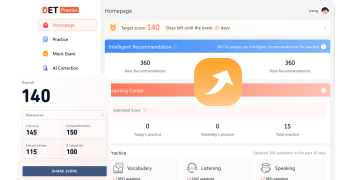การเรียนรู้ในส่วน "อ่านก่อน, แล้วพูด" ของการทดสอบภาษาอังกฤษ Duolingo
การทดสอบภาษาอังกฤษของ Duolingo เป็นวิธีที่สะดวกและประหยัดในการประเมินความสามารถทางภาษาอังกฤษของคุณทางออนไลน์ แตกต่างจากการทดสอบมาตรฐานอื่น ๆ การทดสอบภาษาอังกฤษของ Duolingo มีรูปแบบที่เป็นเอกลักษณ์ที่ปรับตัวตามระดับและทักษะของคุณ หนึ่งในส่วนที่ท้าทายและสำคัญที่สุดของการทดสอบคือส่วน “Read, Then Speak” ซึ่งคุณต้องพูดเกี่ยวกับหัวข้อหนึ่งเป็นเวลา 90 วินาทีหลังจากอ่านคำถามเริ่มต้น
ในบทความนี้ เราจะแสดงให้คุณเห็นถึงวิธีที่จะประสบความสำเร็จในส่วนนี้และเพิ่มคะแนนย่อยด้านการสนทนาและการผลิตของคุณ
เราจะครอบคลุมเรื่อง:
- ทำความเข้าใจกับรูปแบบ “Read, Then Speak”
- เตรียมพร้อมเพื่อการตอบคำถาม
- โครงสร้างการตอบของคุณ
- การส่งมอบคำตอบของคุณ
- เสริมคำตอบของคุณ
- การรวมคำถามตัวอย่างและการตอบสาธิต
- เคล็ดลับและทรัพยากรในการฝึกฝน

ทำความเข้าใจกับรูปแบบ “Read, Then Speak”
ส่วน “Read, Then Speak” เป็นหนึ่งในสี่ประเภทของงานพูดในการทดสอบภาษาอังกฤษของ Duolingo มันขอให้คุณ “พูดเกี่ยวกับหัวข้อต่อไปนี้เป็นเวลา 90 วินาที.”
สำหรับประเภทคำถามนี้ คุณจะเห็นคำถามเขียนบนหน้าจอ คุณจะมีเวลา 20 วินาทีในการอ่านคำถามและเตรียมตอบ จากนั้นทดสอบจะเดินหน้าไปยังหน้าจอบันทึกอัตโนมัติ ที่คุณจะมีเวลา 90 วินาทีในการพูดตอบ คุณจะยังคงเห็นคำถามในขณะที่พูด
คำถามจะถามให้คุณพูดเกี่ยวกับประสบการณ์ส่วนตัว ความคิดเห็น หรือความชอบ ยกตัวอย่างเช่น:
- พูดถึงร้านอาหารที่คุณชื่นชอบ
- กล่าวถึงช่วงเวลาที่คุณต้องตัดสินใจที่ยากลำบาก
- อธิบายงานอดิเรกที่คุณชื่นชอบ
คำถามจะรวมบางจุดย่อเพื่อแนะนำการตอบของคุณ ยกตัวอย่างเช่น:
- มันตั้งอยู่ที่ไหน?
- ชนิดอาหารที่เสิร์ฟคืออะไร?
- คุณไปที่นั่นบ่อยแค่ไหน?
- ทำไมมันถึงเป็นร้านโปรดของคุณ?
คำตอบของคุณจะได้รับคะแนนตามสองคะแนนย่อย: การสนทนาและการผลิต การสนทนาวัดว่าคุณมีปฏิสัมพันธ์กับคำถามและแสดงความคิดของคุณได้ดีแค่ไหน การผลิตวัดว่าคุณใช้คำศัพท์และไวยากรณ์เพื่อสื่อสารอย่างชัดเจนและถูกต้องได้ดีแค่ไหน
เตรียมพร้อมเพื่อการตอบคำถาม
กุญแจสู่คำตอบที่ประสบความสำเร็จคือการเข้าใจคำถามและจัดระเบียบความคิดของคุณในช่วงเวลาสั้น ๆ ต่อไปนี้คือกลยุทธ์บางอย่างที่จะช่วยคุณเตรียมตัว:
- อ่านคำถามอย่างละเอียดและระบุหัวข้อหลักและหัวข้อย่อย ยกตัวอย่างเช่น หากคำถามคือ “พูดถึงร้านอาหารที่คุณชื่นชอบ”, หัวข้อหลักคือร้านอาหารที่คุณชื่นชอบ และหัวข้อย่อยคือตั้งอยู่ที่ไหน ชนิดอาหารที่เสิร์ฟคืออะไร คุณไปที่นั่นบ่อยแค่ไหน และทำไมมันถึงเป็นร้านโปรดของคุณ
- คิดถึงตัวอย่างเฉพาะที่เกี่ยวข้องกับหัวข้อหลัก ยกตัวอย่างเช่น หากร้านอาหารที่คุณชื่นชอบเป็นร้านอาหารไทยใกล้บ้าน ให้คิดถึงเวลาที่คุณจำได้เมื่อคุณไปที่นั่นกับเพื่อนหรือครอบครัว
- ใช้จุดย่อเป็นแนวทางในการจัดโครงสร้างคำตอบของคุณ ยกตัวอย่างเช่น คุณสามารถเริ่มต้นด้วยการแนะนำร้านอาหารที่คุณชื่นชอบ จากนั้นพูดถึงแต่ละจุดย่อตามลำดับ และจบด้วยบทสรุปที่สรุปประเด็นหลักของคุณ
- ใช้เวลาเตรียมตัว 20 วินาทีอย่างมีประสิทธิภาพ คุณสามารถหาคีย์เวิร์ดเพื่อช่วยจำประเด็นหลักของคุณได้ คุณยังสามารถฝึกพูดประโยคแรกของคำตอบของคุณเพื่อเริ่มต้นอย่างมั่นใจ
โครงสร้างการตอบของคุณ
โครงสร้างการตอบที่ชัดเจนและเป็นเหตุเป็นผลจะช่วยให้คุณส่งมอบคำตอบได้อย่างราบรื่นและเชื่อมโยง นี่คือเคล็ดลับบางอย่างที่จะช่วยคุณโครงสร้างคำตอบของคุณ:
- สร้างการแนะนำตัว เนื้อหา และบทสรุป การแนะนำตัวของคุณควรแนะนำหัวข้อหลักและระบุประเด็นหลักของคุณ เนื้อหาของคุณควรพัฒนาแนวคิดหลักโดยการพูดถึงแต่ละหัวข้อย่อยอย่างละเอียด บทสรุปของคุณควรสรุปแนวคิดหลักและจบด้วยข้อสังเกตสุดท้าย
- ใช้คำและวลีเชื่อมโยงเพื่อเชื่อมโยงความคิดและประโยคของคุณ ยกตัวอย่างเช่น คุณสามารถใช้คำเช่น “first”, “second”, “third”, “next”, “then”, “finally”, “also”, “however”, “for example”, “in conclusion”, เป็นต้น
- ตอบทุกส่วนของคำถาม ตรวจสอบให้แน่ใจว่าคุณไม่ได้ข้ามหรือเพิกเฉยต่อจุดย่อใด ๆ หากคุณไม่มีอะไรจะพูดเกี่ยวกับหัวข้อย่อย คุณสามารถยอมรับอย่างสั้น ๆ แล้วไปต่อ ยกตัวอย่างเช่น คุณสามารถพูดว่า “I don’t go there very often, but when I do, I always enjoy it.”
- มุ่งเน้นไปที่หัวข้อ อย่าออกนอกเรื่องหรือรายละเอียดที่ไม่เกี่ยวข้อง หากคุณพบว่าตัวเองออกนอกเรื่อง ให้นำตัวเองกลับมาที่ประเด็นหลักและจุดย่อ
การส่งมอบคำตอบของคุณ
การส่งมอบคำตอบของคุณเป็นสิ่งสำคัญเท่ากับเนื้อหา นี่คือเทคนิคบางอย่างที่จะช่วยให้คุณส่งมอบคำตอบของคุณอย่างชัดเจนและคล่องแคล่ว:
- พูดอย่างธรรมชาติและชัดเจน ใช้ความเร็วและระดับเสียงที่ปกติ อย่าพูดเร็วหรือช้าเกินไป ดังหรือเบาเกินไป ออกเสียงคำของคุณให้ถูกต้องและหลีกเลี่ยงการพูดอ้ำอึ้งหรือพูดไม่ชัด
- ใช้คำและโครงสร้างที่หลากหลาย อย่าพูดคำหรือประโยคเดียวกันซ้ำ ๆ ใช้คำพ้อง คำตรงกันข้าม หรือการถ้อยคำใหม่เพื่อแสดงความคิดเดียวกันในหลายวิธี ใช้คำศัพท์และโครงสร้างทางไวยากรณ์หลายรูปแบบเพื่อแสดงความสามารถและความถูกต้องของคุณ
- จัดการเวลาของคุณดี ๆ คุณมีเวลา 90 วินาทีในการพูดตอบของคุณซึ่งเพียงพอสำหรับการครอบคลุมคำถามและจุดย่อ อย่าพูดนานหรือสั้นเกินไป หากคุณตอบเสร็จก่อนเวลาหมด คุณสามารถเพิ่มรายละเอียดหรือตัวอย่างเพิ่มเติมเพื่อขยายประเด็นของคุณ หากคุณหมดเวลา คุณสามารถสรุปคำตอบของคุณอย่างรวดเร็ว
- ใช้ท่วงทำนองและการเน้นที่หลากหลาย อย่าพูดเสียงเดียวหรือเสียงแบน ใช้การเปลี่ยนแปลงในระดับเสียง ระดับความดัง และการเน้นเพื่อส่งความหมายและอารมณ์ เน้นคำหรือวลีสำคัญในประโยคของคุณ ใช้การขึ้นและลงของระดับเสียงเพื่อส่งสัญญาณคำถามและคำกล่าว
เสริมคำตอบของคุณ
เพื่อให้คำตอบของคุณโดดเด่นและสร้างความประทับใจให้กับผู้ประเมิน คุณสามารถใช้กลยุทธ์บางอย่างเพื่อเสริมคำตอบของคุณและแสดงทักษะการสนทนาของคุณ นี่คือวิธีบางอย่างในการทำเช่นนั้น:
- ใช้คำถามเชิงโวหาร คำถามเชิงโวหารคื คำถามที่คุณถามตัวเองหรือผู้ฟัง แต่คุณไม่คาดหวังคําตอบ พวกมันถูกใช้เพื่อมีส่วนร่วมกับผู้ฟัง, แสดงความคิด, หรือเน้นประเด็น ยกตัวอย่างเช่น คุณสามารถพูดว่า “Who doesn’t love Thai food, right? or What could be better than that?”
- ใช้เรื่องเล่าหรือเรื่องราว เรื่องเล่าหรือเรื่องราวเป็นเรื่องสั้นและน่าสนใจของประสบการณ์หรือเหตุการณ์ส่วนตัว พวกมันถูกใช้เพื่อแสดงประเด็น, ให้ตัวอย่าง, หรือเพิ่มอารมณ์ขัน ยกตัวอย่างเช่น คุณสามารถพูดว่า “One time, I ordered the spiciest dish on the menu, and I regretted it so much. My mouth was on fire, and I had to drink three glasses of water to cool it down.”
- ใช้ความคิดเห็นหรือความรู้สึก ความคิดเห็นหรือความรู้สึกคือมุมมองส่วนตัวหรืออารมณ์ของคุณเกี่ยวกับหัวข้อ พวกมันถูกใช้เพื่อแสดงบุคลิกภาพ, มุมมอง, หรือทัศนคติของคุณ ยกตัวอย่างเช่น คุณสามารถพูดว่า “I think Thai food is the best cuisine in the world.” or “I feel so happy and relaxed when I go to my favorite restaurant.”
คำถามตัวอย่างและการตอบสาธิต
เพื่อให้คุณได้แนวคิดดียิ่งขึ้นในการนำเคล็ดลับและกลยุทธ์ที่เราได้กล่าวมาใช้ มาดูคำถามตัวอย่างและการตอบสาธิตสำหรับส่วน “Read, Then Speak”
คำถามตัวอย่าง:
Discuss a time when you had to make a difficult decision.
What was the situation?
What choices were available to you?
Why did you make the decision you did?
คำตอบสาธิต:
Well, I’d say one of the toughest decisions I’ve ever had to make was figuring out where I wanted to go to college after I finished up high school. I had gotten accepted to a few different schools and it definitely wasn’t an easy choice to make.
Let’s see, first off, I should probably give you some background real quick on the different colleges I got into. There was this small liberal arts college pretty close to home that I applied to. It was a nice little school. Then there was this huge state university that was like 5 hours away – it was really big with tons of students. And last, I applied to this Ivy League school all the way on the other side of the country. I had worked really hard to get awesome grades and test scores in high school so I could have some good options to choose from.
So each school had their own pros and cons that I had to think about. The small college was nearby and I already knew some kids going there. But it didn’t have the big name like the Ivy League did. The state school was a lot more affordable but it was so big I worried I wouldn’t get enough personal attention from professors. And the Ivy League school was super prestigious, but way more competitive and expensive too.
After visiting all 3 campuses, I decided the small liberal arts college was the best option for me. I really liked the small class sizes and how tight-knit the community felt. They also gave me a great financial aid package that made it possible to afford. I knew I’d get to work closely with professors and get individualized attention there, and that was huge for me.
So in the end, I went with my gut telling me the small school was the right call. I didn’t want to pass up the chance to really get mentored and be part of a community just because the Ivy League name carried more weight. And I’m stoked with my choice – I’ve gotten to have experiences at this school I don’t think I would’ve had anywhere else. So for me, I’m happy with my decision.
เคล็ดลับและทรัพยากรในการฝึกฝน
วิธีที่ดีที่สุดในการพัฒนาทักษะการพูดของคุณและเตรียมพร้อมสำหรับส่วน “Read, Then Speak” คือการฝึกฝนเป็นประจำและสม่ำเสมอ ต่อไปนี้คือบางวิธีและทรัพยากรที่จะช่วยคุณฝึกฝน:
- จำลองสภาพแวดล้อมการทดสอบ พยายามสร้างเงื่อนไขของการทดสอบจริงให้เหมือนมากที่สุด ใช้คอมพิวเตอร์ที่มีเว็บแคมและไมโครโฟน และหาสถานที่เงียบสงบและสะดวกสบายในการทำการทดสอบ ตั้งเวลา 20 วินาทีเพื่ออ่านคำถามและ 90 วินาทีเพื่อพูดตอบ บันทึกตัวเองและฟังการแสดงของคุณ ระบุจุดแข็งและจุดอ่อนของคุณ และทำงานเพื่อปรับปรุง
- ใช้ทรัพยากรออนไลน์ มีทรัพยากรออนไลน์มากมายที่สามารถช่วยให้คุณฝึกฝนทักษะการพูดและเตรียมพร้อมสำหรับการทดสอบภาษาอังกฤษของ Duolingo ยกตัวอย่างเช่น คุณสามารถใช้ เว็บไซต์ DET อย่างเป็นทางการ เพื่อเรียนรู้เพิ่มเติมเกี่ยวกับรูปแบบการทดสอบ การให้คะแนน และคำแนะนำ คุณยังสามารถใช้ ฐานข้อมูลคำถามการฝึกฝนการทดสอบภาษาอังกฤษของ Duolingo ของเราเพื่อทำความคุ้นเคยกับการทดสอบได้
คลิกที่นี่สำหรับ กลยุทธ์การเตรียมสอบ DET
กำลังมองหาเคล็ดลับใน DET? ค้นหาที่นี่: https://www.detpractice.com/category/pro-test-tips/
เริ่มฝึกฝนวันนี้โดยการสมัครใช้งาน ฐานข้อมูลคำถาม DET ได้ฟรี






